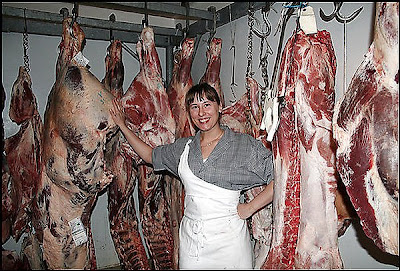So many letters in response to that New York Times article (in the previous post) about how the author learned to love goat meat. A lot of recipe sharing and gratitude for being turned on to a new kind of meat, a few disgusted vegans and vegetarians, some aggressive rebuttals from carnivores who, like Moses receiving the tablets, have had revealed to them the truth that mankind was designed to eat meat. On to some of the letters.
A rancher in Montana wrote...I wanted to address, as a rancher, some of the concerns that I have seen expressed from those who believe a goat, or any meat for that matter, is not to be eaten.Many of us who raise livestock as independent producers are just as sickened as my vegetarian friends at the site [sic] of confined animal feeding operations ... Goats are ... truly a pleasure to raise. The most difficult time of year is when it comes time to kill. I sell my animals on the hoof, and if someone wants meat I will then process it for them after they own it. Even though it is painful every time, I feel like I owe them the most humane end possible. This means they should die with dignity on the ranch they were born to avoid the stress of shipping, etc. It comes quickly and cleanly. Our animals never know fear, anxiety or cruelty ... Every time we eat meat, there was a profound sacrifice made that should be deeply appreciated.
--- MPS, Montana
Dear Sir,
I am writing in reference to the letter by the rancher MPS from Montana. I know this rancher well. He is a good man capable of some of the most breathtaking distortions of reality I have ever encountered. I can't tell you how astounded I am by his ability to convince himself that he is genuinely saddened when he slaughters his goats.
Sincerely Yours,
the Montana Rancher's container of antipsychotic drugs
Dear Times,
I read the condescending letter from the Montana Rancher's antipsychotic drugs. I'm one of the goats that rancher MPS will soon slaughter. It just breaks my heart when I think of how bad he feels that he has to kill me after he named me and patted me on the head every morning. It's not easy for me either. Always in the back of my mind I know the time is coming when rancher MPS has to suffer the trauma of killing me. It pains me to see him in such pain and know I'm responsible for it. I'll try not to bleat in horror when he yanks my head back because that will just intensity his guilt. Don't blame yourself, Rancher MPS. It's not your fault that you have to slit my throat. It's my fault for having flesh people love to eat.
Yours,
Cyrano the Goat.
Dear Times,
I'm writing to clarify a letter from your reader Cyrano the Goat. AS you may have guessed, it wasn't really written by a goat. Rancher MPS projects many of his uncomfortable feelings into a persona which takes the form of a sympathetic goat on its way to slaughter. I'm afraid I have to side with Rancher MPS's container of antipsychotic drugs on this one.
All the best,
Reality
Dear Times,
I don't want to get in the middle of things here, but I can only report what I see in front of me. The goats are terrified. Their eyes look like they're about to explode with fear. Rancher MPS calls it a humane death? he says they never know fear, terror or cruelty? Say what? are we attending the same slaughter?
Sincerely,
Rancher MPS's knife
Times,
REality can go F itself and so can antipsychotic drgus. What the F do they know? REality's basically calling me stupid, saying I can't form my own thoughts, saying rancher MPS is projecting his thoughts onto me. Now that's what I call speciesism. Why don't those F'ing vegans attack reality and antipsychotic drugs instead of decent people like Rancher MPS? As a matter of fact, Rancher MPS does consult with us goats before he slaughters us. He says to us, hey, guys, there's a customer of mine who wants to eat your flesh. He's going to pay me good money. What do you think? And we say to him, we're just grateful to be able to slaughtered by a compassionate person like yourself instead of those horrible factory farms.
Sincerely,
Cyrano the Goat
p.s. you've got me all confused, Reality and antipsychotic drugs, and you're going to pay for it! Maybe I'll start selling you guys by the hoof to the highest bidder. How'd you two punks like that, huh, see you in hell, your worst enemy, Rancher MPS, I mean, Cyrano the Goat.



